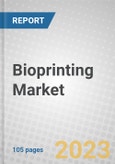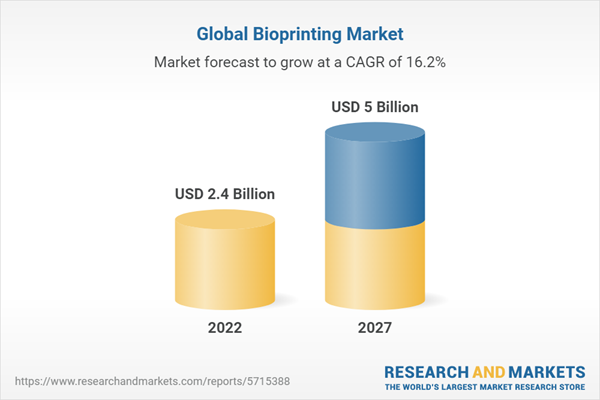The global bioprinting technologies market should reach $5.0 billion by 2027 from $2.4 billion in 2022 at a compound annual growth rate (CAGR) of 16.2% for the forecast period of 2022 to 2027.
Report Includes
- 26 data tables and 35 additional tables
- An up-to-date review and analysis of the global markets for bioprinting technologies and applications within the industry
- Analyses of the global market trends, with market revenue data from 2019 to 2021, estimates for 2022, and projections of compound annual growth rates (CAGRs) through 2027
- Highlights of market opportunities for this innovation-driven market, and the major regions and countries involved in market developments
- Estimation of the actual market size and revenue forecast for global bioprinting market in USD millions, and corresponding market share analysis by type of technology, application, end-user, and region
- Technology assessment of the key drivers, restraints and opportunities that will shape the market for bioprinting over the forecast period (2022 to 2027)
- Analysis of the markets for the main bioprinting end-use applications, including research, drug discovery and development, cosmetics, and clinical
- Discussion of the industry value chain analysis providing a systematic study of key intermediaries involved, with emphasis on technologies, applications, and end users of bioprinting
- Updated information on recent industry acquisitions, partnerships, agreements, collaborations, and other strategic alliances in the global bioprinting market
- Identification of the major stakeholders and analysis of the competitive landscape based on recent developments and segmental revenues
- Profile descriptions of the market-leading participants, including 3D Bio Corp., Advanced Solutions Inc., Cellink, Organovo, and Stratasys Ltd.
Table of Contents
Chapter 1 Introduction
1.1 Study Goals and Objectives
1.2 Reasons for Doing this Study
1.3 What's New in this Report?
1.4 Scope of Report
1.5 Information Sources
1.6 Methodology
1.7 Geographic Breakdown
1.8 Analyst's Credentials
1.9 Custom Research
1.10 Related Research Reports
Chapter 2 Summary and Highlights
Chapter 3 Market Overview
3.1 Bioprinting Product Life Cycle
3.2 Bioprinting Industry
3.3 Bioprinting Instrument Technologies
3.3.1 Software
3.3.2 Organ-On-Chip
3.4 Organs and Organoids
3.4.1 Organoids
3.4.2 Organs
3.5 Technological Challenges in Printing Organs
3.6 Bioprinting Applications
3.7 Innovations in Medical/Healthcare Products
3.7.1 Diagnosing Diseases
3.7.2 Monitoring Patients
3.7.3 Personalized Medicine
3.8 Current Trends
3.8.1 Enhanced Cybersecurity
3.8.2 Internet of Medical Things (Iomt)
3.8.3 Medical Robots
3.8.4 3D Printed Objects
3.8.5 Device Connectivity
3.9 Regulations and Legislation
3.9.1 Europe
3.9.2 U.S.
3.9.3 Japan
Chapter 4 Market Dynamics
4.1 Market Dynamics
4.1.1 Drivers
4.1.2 Restraints
4.1.3 Opportunities
4.1.4 Strategies
4.1.5 Trends
Chapter 5 Impact of the Covid-19 Pandemic
5.1 Impact of Covid-19 on the Market for Bioprinting
5.1.1 Personal Protective Equipment (Ppe)
5.1.2 Face Masks
5.1.3 Face Shields
5.1.4 3D Printing in Healthcare
Chapter 6 Global Market for Bioprinting Technologies
6.1 Overview
6.2 Droplet Disposition
6.2.1 Market Outlook
6.3 Photopolymerization
6.3.1 Market Outlook
Chapter 7 Global Market for Bioprinting End Uses
7.1 Overview
7.2 Drug Discovery and Development
7.2.1 Market Outlook
7.3 Research
7.4 Cosmetics
7.5 Other End Uses
Chapter 8 Global Market for Bioprinting Technologies by Region
8.1 Overview
8.2 North America
8.2.1 Market Outlook
8.3 Europe
8.3.1 Market Outlook
8.4 Asia-Pacific
8.4.1 Market Outlook
8.5 Rest of the World
8.5.1 Market Outlook
Chapter 9 Competitive Landscape
Chapter 10 Company Profiles
- 3D Bio Corp.
- 3D Bioprinting Solutions
- 3D Systems Inc.
- Advanced Solutions Inc.
- Aspect Biosystems Ltd.
- Cellink
- Cyfuse Biomedical
- Collplant Biotechnologies Ltd.
- Organovo Holding Inc.
- Precise Bio
- Stratasys Ltd.
- Other Companies
List of Tables
Summary Table: Global Market for Bioprinting Technologies, by Type, Through 2027
Table 1: Life Cycle of Bioprinting Products
Table 2: Characteristics of Bioprinting Industry Segments
Table 3: Comparison of Bioprinting with 3D Printing
Table 4: Bioprinting Instrument Technologies
Table 5: Public Policy Issues Related to Bioprinted Organs
Table 6: Bioprinting of Organs: Technological Challenges
Table 7: Bioprinting Applications
Table 8: Class I and II Exempt Devices
Table 9: Applications of Bioprinting in Cancer Tissue Engineering
Table 10: 3D Bioprinting Technologies in Development for COVID-19 Vaccines and Therapeutics
Table 11: Global Market for Bioprinting Technologies, by Type, Through 2027
Table 12: Global Market for Bioprinting Technologies, by Type of Droplet Disposition, Through 2027
Table 13: Global Market for Bioprinting Technologies, by Photopolymerization Technique, Through 2027
Table 14: Global Market for Bioprinting Technologies, by End Use, Through 2027
Table 15: 3D Printed Drug Delivery Systems
Table 16: Global Market for Bioprinting Technologies, by Region, Through 2027
Table 17: North American Market for Bioprinting Technologies, by Type, Through 2027
Table 18: North American Market for Bioprinting Technologies, by Type of Droplet Disposition, Through 2027
Table 19: North American Market for Bioprinting Technologies, by Photopolymerization Technique, Through 2027
Table 20: North American Market for Bioprinting Technologies, by End Use, Through 2027
Table 21: North American Market for Bioprinting Technologies, by Country, Through 2027
Table 22: European Market for Bioprinting Technologies, by Type, Through 2027
Table 23: European Market for Bioprinting Technologies, by Type of Droplet Disposition, Through 2027
Table 24: European Market for Bioprinting Technologies, by Photopolymerization Technique, Through 2027
Table 25: European Market for Bioprinting Technologies, by End Use, Through 2027
Table 26: European Market for Bioprinting Technologies, by Country, Through 2027
Table 27: Asia-Pacific Market for Bioprinting Technologies, by Type, Through 2027
Table 28: Asia-Pacific Market for Bioprinting Technologies, by Type of Droplet Disposition, Through 2027
Table 29: Asia-Pacific Market for Bioprinting Technologies, by Photopolymerization Technique, Through 2027
Table 30: Asia-Pacific Market for Bioprinting Technologies, by End Use, Through 2027
Table 31: Asia-Pacific Market for Bioprinting Technologies, by Country, Through 2027
Table 32: Rest of the World Market for Bioprinting Technologies, by Type, Through 2027
Table 33: Rest of the World Market for Bioprinting Technologies, by Type of Droplet Disposition, Through 2027
Table 34: Rest of the World Market for Bioprinting Technologies, by Photopolymerization Technique, Through 2027
Table 35: Rest of the World Market for Bioprinting Technologies, by End Use, Through 2027
Table 36: Rest of the World Market for Bioprinting Technologies, by Country, Through 2027
Table 37: Recent Developments in the Global Market for Bioprinting Technologies, 2018-2022
Table 38: 3D Bio Corp.: Product Portfolio
Table 39: 3D Bio Corp.: Recent Developments, 2022
Table 40: 3D Bioprinting Solutions: Product Portfolio
Table 41: 3D Bioprinting Solutions: Recent Developments, 2014-2021
Table 42: 3D Systems, Inc.: Product Portfolio
Table 43: 3D Systems, Inc.: Recent Developments, 2020-2022
Table 44: Advanced Solutions Inc.: Product Portfolio
Table 45: Advanced Solutions Inc.: Recent Developments, 2019-2021
Table 46: Aspect Biosystems Ltd.: Product Portfolio
Table 47: Aspect Biosystems Ltd.: Recent Developments, 2019-2022
Table 48: Cellink: Product Portfolio
Table 49: Cellink: Recent Developments, 2022
Table 50: Cyfuse Biomedical: Product Portfolio
Table 51: Cyfuse Biomedical: Recent Developments, 2019-2021
Table 52: CollPlant: Product Portfolio
Table 53: CollPlant: Recent Developments, 2022
Table 54: Organovo: Product Portfolio
Table 55: Organovo: Recent Developments, 2022
Table 56: Precise Bio: Product Portfolio
Table 57: Precise Bio: Recent Developments, 2018-2022
Table 58: Stratasys Ltd.: Product Portfolio
Table 59: Stratasys Ltd.: Recent Developments, 2022
Table 60: Other Bioprinting Startups
List of Figures
Summary Figure: Global Market for Bioprinting Technologies, by Type, 2019-2027
Figure 1: Medical Device Marketing Process in the U.S.
Figure 2: Global Population Aging 60+ Years, by Region, 2015-2050
Figure 3: Global Projected Diabetes Patients Aged 20-79, 2010 and 2030
Figure 4: Workflow Structure and Emergency Use Authorization of 3D Printed Products
Figure 5: Global Market Shares of Bioprinting Technologies, by Type, 2021
Figure 6: Global Market Shares of Bioprinting Technologies, by Type of Droplet Disposition, 2021
Figure 7: Global Market Shares of Bioprinting Technologies, by Photopolymerization Technique, 2021
Figure 8: Global Market Shares of Bioprinting Technologies, by End Use, 2021
Figure 9: Drug Discovery Pipeline with Retooling 3D Printing Technologies
Figure 10: North American Market Shares of Bioprinting Technologies, by Type, 2021
Figure 11: North American Market Shares of Bioprinting Technologies, by Type of Droplet Disposition, 2021
Figure 12: North American Market Shares of Bioprinting Technologies, by Photopolymerization Technique, 2021
Figure 13: North American Market Shares of Bioprinting Technologies, by End Use, 2021
Figure 14: North American Market Shares of Bioprinting Technologies, by Country, 2021
Figure 15: U.S. Elderly (65+ Years) Population, 2010-2050
Figure 16: European Market Shares of Bioprinting Technologies, by Type, 2021
Figure 17: European Market Shares of Bioprinting Technologies, by Type of Droplet Disposition, 2021
Figure 18: European Market Shares of Bioprinting Technologies, by Photopolymerization Technique, 2021
Figure 19: European Market Shares of Bioprinting Technologies, by End Use, 2021
Figure 20: European Market Shares of Bioprinting Technologies, by Country, 2021
Figure 21: Asia-Pacific Market Shares of Bioprinting Technologies, by Type, 2021
Figure 22: Asia-Pacific Market Shares of Bioprinting Technologies, by Type of Droplet Disposition, 2021
Figure 23: Asia-Pacific Market Shares of Bioprinting Technologies, by Photopolymerization Technique, 2021
Figure 24: Asia-Pacific Market Shares of Bioprinting Technologies, by End Use, 2021
Figure 25: Asia-Pacific Market Shares of Bioprinting Technologies, by Country, 2021
Figure 26: Rest of the World Market Shares of Bioprinting Technologies, by Type, 2021
Figure 27: Rest of the World Market Shares of Bioprinting Technologies, by Type of Droplet Disposition, 2021
Figure 28: Rest of the World Market Shares of Bioprinting Technologies, by Photopolymerization Technique, 2021
Figure 29: Rest of the World Market Shares of Bioprinting Technologies, by End Use, 2021
Figure 30: Rest of the World Market Shares of Bioprinting Technologies, by Country, 2021
Figure 31: Bioprinting Company Ranking Analysis, 2021
Figure 32: Top Bioprinting Startups Ranking, 2021
Samples

LOADING...
Executive Summary
The use of technology in medical devices impacts multiple therapeutic areas. The most significant user segments include tissue engineering, drug discovery, and regenerative medicine. As per the WHO, 21 patients per day die due to organ transplant shortages. Bioprinted organs could help clinicians and patients to eliminate the list of requirements of organs. The technology has been used as one of the most impactful possibilities in the field.
Laser bioprinting is growing at a high rate due to its advantages in high print speeds, high cell densities, good cell viability, and higher resolution patterns. Also, since there is no nozzle, there are no issues with a nozzle clogging with cells or other materials during printing.
The main advantage of the photopolymerization technique is achieving covalently crosslinked hydrogels, helping to drive the use and growth of these bioprinters. Advantages include the ability to print high-viscosity biomaterials, the creation of large constructs, high cell densities, sterile environments, and affordability.
Inkjet bioprinters have the advantages of high print speed, high cell viability, and high-resolution structures. Inkjet printers are limited to low-viscosity materials, and as a result, the printed structure may have weak mechanical properties.
Companies Mentioned
- 3D Bio Corp.
- 3D Bioprinting Solutions
- 3D Systems Inc.
- Advanced Solutions Inc.
- Aspect Biosystems Ltd.
- Cellink
- Collplant Biotechnologies Ltd.
- Cyfuse Biomedical
- Organovo Holding Inc.
- Precise Bio
- Stratasys Ltd.
Table Information
| Report Attribute | Details |
|---|---|
| No. of Pages | 105 |
| Published | January 2023 |
| Forecast Period | 2022 - 2027 |
| Estimated Market Value ( USD | $ 2.4 Billion |
| Forecasted Market Value ( USD | $ 5 Billion |
| Compound Annual Growth Rate | 16.2% |
| Regions Covered | Global |
| No. of Companies Mentioned | 11 |









